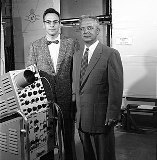Neutrino

Contrary to what the name might suggest, the neutrino (denoted by the Greek letter ν) is not a kind of mini-neutron, but a particle that is closely related to the electron. Like the neutron, the neutrino has no charge, but its mass is about a billion times smaller than that of the neutron.
The neutrino hardly interacts with matter. The half-value thickness of water for 1 MeV neutrinos is 1019 m, which is the unimaginably far distance light travels in 1000 years.
History
The neutrino was postulated in 1930 by the Austrian physicist Wolfgang Ernst Pauli (1900 – 1958). Its existence was first demonstrated in 1956 by the American physicists Clyde Lorraine Cowan (1919 – 1974) and Frederick Reines (1918 – 1998).
The name is the Italian equivalent of "little neutral one" and was jokingly coined in order to distinguish this light neutral particle from the heavy neutron.
